-
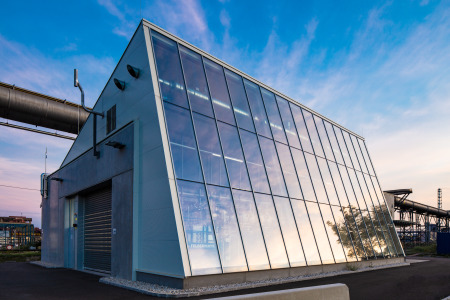
Breakthrough technologies are processes that change our lives or the landscape of an industrial sector, bringing far-reaching consequences. Breakthrough technologies are particularly relevant to the pressing problem of climate change, offering solutions for storing green energy, for example, or the transformation from high to low emission, or even zero emission, technologies.
The voestalpine Group is also intensively researching into breakthrough technologies for steel production in order to successively increase the use of green hydrogen in the steel production process over the long term and achieve carbon-neutral steel production by 2050. The most important research projects include the H2FUTURE hydrogen pilot facility at the site in Linz which is examining the manufacture and exploitation of “green” hydrogen on an industrial scale, and the SuSteel facility at the site in Donawitz for testing the sustainable production of steel from iron ore in a single process step using hydrogen plasma. voestalpine Stahl Donawitz has also joined Primetals Technologies to conduct research into a procedure which uses hydrogen to reduce iron ore in a fluidized state (Hyfor).
-

Corporate responsibility (CR) is a company’s accountability for the impact of its business activities, on society, its employees, the natural and the business environment. Corporate responsibility is an integral part of the voestalpine Group’s corporate strategy and culture. Responsible management considers aspects such as risk management, the environment & ecology, employees, society & culture, and research & development. The seriousness with which voestalpine takes its economic, social, and ecological responsibilities is also laid out in the Group’s annual Corporate Responsibility Report.
As an industry pioneer in environmental protection, voestalpine is continually implementing new measures to reduce the consumption of resources in steel production, as well as following a long-term decarbonization strategy. The Group also actively helps to protect the climate with products including lightweight construction steels for the automotive industry, fully digital rail infrastructure systems, and innovative steel solutions for renewable energy generation. Furthermore, voestalpine prioritizes responsible and transparent supply chain management.
The Group’s focus on sustainability is also mirrored in its placing of a syndicated sustainability loan, with its interest rate linked, amongst others, to its sustainability performance. The Group has also been included in the respected international sustainability index FTSE4Good. Furthermore, voestalpine supports the UN Global Compact, the world’s largest and most significant initiative for responsible corporate management and is part of industry initiatives such as Responsible Steel which is dedicated to sustainable steel production. In 2022, the voestalpine Group also achieved Leadership level with an A- climate protection rating in the Carbon Disclosure Project (CDP). This rating honors companies which have taken coordinated climate protection measures and implemented best practices.
-
voestalpine.jpg)
Decarbonization is the sustained reduction of carbon, an element which significantly contributes to global warming by combining to form carbon dioxide (CO2), a greenhouse gas, during the combustion process. The term gained prominence following the 2015 Paris Climate Agreement which established a global framework for combating climate change.
A fundamental requirement for creating a future climate-neutral global economy is to decarbonize energy-intensive industries such as the steel industry, one of the world’s largest emitters of CO2. voestalpine is helping to achieve the global climate goals with greentec steel and is already working at full speed to develop technical scenarios at its sites in Linz and Donawitz which will drive forward decarbonization of steel production.
-
voestalpine.jpg)
Direct reduction is an important bridging technology for decarbonizing steel production. It reduces iron ore to iron with natural gas, rather than coal and coke, resulting in fewer CO2 emissions. The direct reduction process is used to produce HBI (Hot Briquetted Iron), a sophisticated and environmentally friendly pre-material in steel production. HBI can replace coke and ore in a blast furnace, and scrap in an electric arc furnace.
Another advantage of the direct reduction process is that the process gases can be recycled, and the heat generated during production recovered. In 2016, voestalpine began operating a direct reduction plant in Texas, USA, subsequently selling a majority stakeholding in the plant to ArcelorMittal. This partnership secures the Group’s long-term supply of the HBI produced at the site, in turn providing the basis for further decarbonization of steel production in Linz and Donawitz (greentec steel).
-
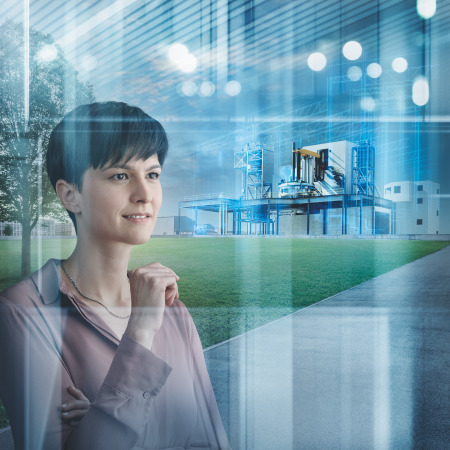
The use of electric arc furnaces as a low carbon alternative to the traditional blast furnace LD route is an essential building block for the future decarbonization of the steel industry.
In the electric arc furnace hot sponge iron (HBI) rather than coal or coke is used to produce steel. Scrap and liquid pig iron are also added to the mix. HBI and scrap are melted down by an electric arc which reaches temperatures of over 3,000°C. The furnace is tilted to pour out the slag and tap the crude steel. voestalpine plans to operate an electric arc furnace at each of the sites in Linz and Donawitz starting in 2027. The preparatory work at both sites has already started.
-
Established in 2005, the European emissions trading system (EU-ETS) includes all EU Member States as well as Norway, Iceland, and Liechtenstein. The EU regards the emissions trading system as the key to reducing greenhouse gas emissions. It prices and limits emissions from over 11,000 energy-intensive facilities, primarily in the power generation and manufacturing industries, as well as intra-European airlines. One certificate covers one ton of carbon dioxide emissions. Certificates are traded on special exchanges and in the capital markets; their price reflects not only the rules of supply and demand but is also influenced by speculation. However, the overall number of issued certificates is limited, and will be gradually reduced through to 2030.
Emissions-intensive industries such as steel production are issued with a certain volume of emission rights at no charge (“free certificates”). This “carbon leakage” protection is intended to prevent certain industries from shifting their production to countries with less stringent climate protection regulations.
The EU’s “Fit for 55” (cf. global and European climate goals) package of measures agreed in 2021 is intended to significantly cut back on future certificate issues, and to speed up the annual reduction. In addition, the previous free distribution of emissions certificates to particularly energy-intensive companies facing international competition is scheduled to gradually cease, to be replaced by a carbon border adjustment mechanism.
Sources:
- https://www.voestalpine.com/blog/en/commitment/environment/responsibility-and-a-sense-of-proportion-voestalpine-and-co2-certificates/
- https://www.umweltbundesamt.de/daten/klima/der-europaeische-emissionshandel#teilnehmer-prinzip-und-umsetzung-des-europaischen-emissionshandels
- https://www.bundeskanzleramt.gv.at/themen/europa-aktuell/fit-for-55-paket-eu-kommission-geht-herausforderungen-zum-klimaschutz-an.html
-

Company sustainability ratings and indices are often based on the analysis of environmental, social, and governance factors, so-called ESG criteria. Investors have also adopted the term as a means of evaluating sustainable investments. Accordingly, sustainability covers not only ecological considerations, such as climate and environmental protection, or energy efficiency, but also social aspects including workplace safety, health protection, and social engagement. Sustainable corporate governance is another relevant criterium.
-
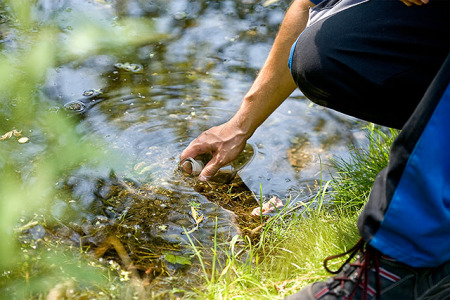
In 2015 the United Nations’ Paris Agreement set the world ambitious goals: to limit global warming to significantly less than 2 degrees Celsius—ideally 1.5 degrees Celsius—above pre-industrial levels. Additionally, countries are expected to enhance their ability to adapt to climate change, and to organize global financial flows to support climate protection.
The climate goals for the EU are set out in the European Green Deal, requiring the EU Member States to effectively become carbon neutral by 2050, and to reduce net greenhouse gas emissions by at least 55% compared to 1990 by 2030.
The “Fit for 55” package includes the legal instruments needed to realize the European climate goals and to fundamentally restructure the economy and society. The long-term goal is to convert the economy to use renewables and adopt zero emission production methods in every EU Member State.
Accordingly, there is great pressure on Europe’s steel industry which plays a key role in the climate debate by currently accounting for more than 6% of total EU carbon emissions from fossil fuels. The voestalpine Group has clearly committed to achieving these goals, and is already working at full speed to develop technical scenarios which will drive decarbonization of the steel production process at its sites in Linz and Donawitz.
-
voestalpine.jpg)
Green hydrogen is seen as the most promising future option for a successful global energy transition. The goal is to use this climate-neutral energy source as a seasonal storage medium, storing energy generated in the summer for use in the winter months, and as a source of energy for energy-intensive industry.
Generating and using green hydrogen sourced from renewables is a key technology in the move to reduce carbon emissions. However, safely transporting and correctly storing hydrogen are major challenges in the transition to this new energy source. As a long-term, leading partner to the global energy industry, voestalpine brings its expertise in generating, transporting, and storing hydrogen to the table.
As well as developing high-quality product solutions for its customers, the Group is also conducting research into a variety of breakthrough technologies for the future manufacture of steel using green hydrogen. The Group’s key research projects include the H2FUTURE hydrogen pilot facility at the premises in Linz for manufacturing and using “green” hydrogen on an industrial scale, and the SuSteel testing facility in Donawitz for carbon-neutral steel production using hydrogen plasma to reduce iron ore.
-
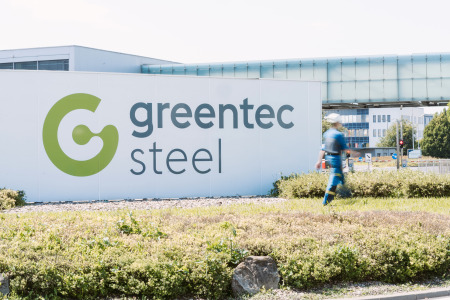
voestalpine is committed to the climate goals as set out in the 2015 Paris Climate Agreement, and is following a consistent, long-term strategy to directly avoid carbon emissions.
greentec steel is an ambitious and feasible phased plan with which voestalpine can make a valuable contribution to achieving the climate goals. In the first step starting in 2027, the Group plans to replace two blast furnaces with two electric arc furnaces (EAFs). The investment volume will be around EUR 1.5 billion. By partially switching from the blast furnace to the electric steel route, CO2 emissions can be reduced by up to 30% as early as 2027. This corresponds to savings of almost 4 million tons of CO2 per year—nearly 5% of Austria’s annual CO2 emissions, making greentec steel the country’s largest climate protection program. » Construction of the two EAFs is scheduled to start in 2024, and three years later one electric arc furnace will go into operation at each of the sites in Linz and Donawitz. The exact start of implementation depends on the clarification of unresolved funding issues in Austria. As of 2030, voestalpine plans to replace another blast furnace at each of the sites in Linz and Donawitz.
The Group is already researching several new processes to achieve its goal of CO2 neutrality by 2050, and investing in pilot projects that explore new pathways in steel production. These include research projects such as the H2FUTURE hydrogen pilot facility at the premises in Linz for manufacturing and using “green” hydrogen on an industrial scale, and the testing facilities at the Donawitz site for CO2-neutral steel production using hydrogen plasma to reduce iron ore.
-

greentec steel is our ambitious plan for the long-term decarbonization of steel production. For more than a year we have been offering a CO2-reduced greentec steel edition for all Steel Division flat steel products.
This includes electrical steel, which is used in wind turbines, and high-tensile steels for lightweight automotive construction. This is made possible due to an innovative raw materials mix and even more efficient processes. We can meet growing customer demand in the high-quality sector with our innovative greentec steel edition product solutions, while at the same time making a contribution to achieving the global climate goals. We have a clear goal: quality leadership in CO2-reduced and CO2-neutral steel production.
-
In addition to scrap and liquid pig iron, hot briquetted iron (HBI) is the most important pre-material for the future carbon-neutral production of high-quality steel. HBI is produced in a direct reduction process. In addition to carbon neutrality, the process offers other advantages. For example, the biogenic carbon allows carburization of the sponge iron for efficient melting in the electric arc furnace.
The European Patent Office has granted voestalpine the intellectual property rights for the development of an industrial-scale process for producing sponge iron (HBI) via direct reduction with green hydrogen. The patent is valid in all major European steel-producing countries.
-
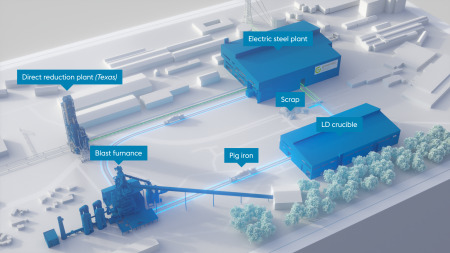
The hybrid concept is the basis for achieving the hydrogen-based transformation by 2050. Here liquid pig iron and sponge iron (HBI) join scrap as the most important pre-materials for tomorrow’s carbon-neutral production of high-quality steel. This would allow the carbon emissions from steel production at Linz and Donawitz to be significantly reduced from 2027, by around 30%, representing an annual savings of almost 4 million tons of CO2.
-
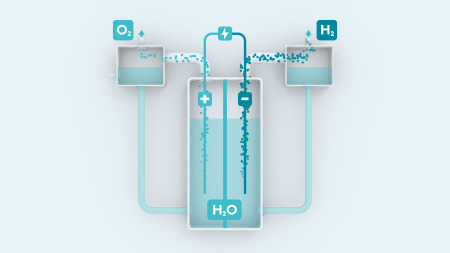
Hydrogen electrolysis is the process of using electricity (generated from renewables) to break down water into hydrogen and oxygen. One relatively recent and highly innovative technology of this type is PEM (Proton Exchange Membrane) electrolysis in which a proton-conducting membrane separates the areas in which oxygen and hydrogen form. Electrodes made from special steel are fixed to either side of the membrane, and connected to the positive and negative terminals on the power supply. This is where the water is split.
This PEM technology is used in what is currently the world’s largest pilot facility for the carbon neutral production of green hydrogen in the steel industry to date. It commenced operation on voestalpine premises in fall 2019. With a capacity of 6 megawatts, the Siemens “Silyzer 300” PEM electrolysis module can produce 1,200 m³ of “green” hydrogen an hour.
-
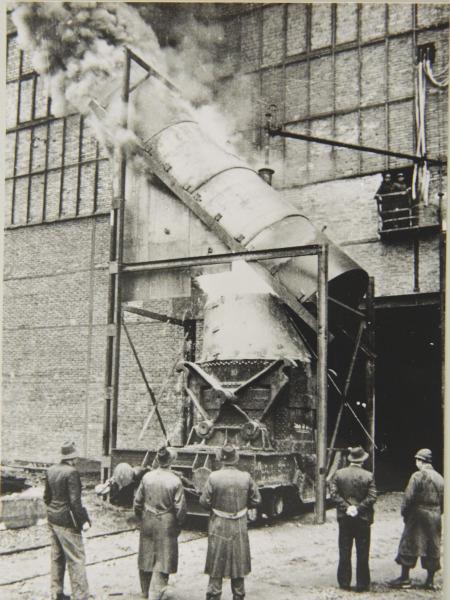
The Linz-Donawitz process (LD process) developed by voestalpine in 1952 revolutionized steel manufacturing and is used in around 70 percent of global steel production to this day. The LD process involves blowing pure oxygen over liquid pig iron. This facilitates and accelerates the combustion of pig iron companion elements such as carbon, phosphorus, and sulfur. The key feature of steel produced using the LD process is its purity, allowing it to be 100% recycled with no loss of quality.
voestalpine’s first series of tests which finally culminated in the LD process began in the late 1940s. On November 27, 1952, the world’s first LD steelmaking plant went into operation on the site of today’s voestalpine AG, with a second plant opening in Donawitz on May 22, 1953. At a stroke, the “invention of the century” revolutionized the global steel industry and created the foundations for the voestalpine Group’s metallurgical leadership, as well as its consistent focus on quality and technology.
-

Life Cycle Assessment (LCA) is an instrument for assessing the environmental impact of a product over its entire service life, starting from raw materials extraction, including its production, and right through to the end of its operating life (e.g., recycling).
The LCA approach illustrates the ecological advantages offered by steel: products made from steel are not only durable, they can also be reused and repaired, extending their service life. At the end of a product’s life cycle—for example, a car—the steel can be reintroduced into the production cycle in the form of scrap.
Worldwide, around 600 million tons of steel scrap is recycled each year. The voestalpine Group is one example, using more than 25% scrap in its steel production. This is significantly higher than the European average of 19%, and more than twice as much as in China.
-

voestalpine is a global technology leader in the production of ultra-high strength and simultaneously lightweight body parts for the automotive industry. One advantage of lightweight body parts is that they help to reduce vehicle fuel consumption, in turn lowering CO2 emissions. Lightweight construction also plays an important role in e-mobility, extending vehicle range by compensating for the heavy battery weight.
voestalpine has already set new global standards in the production of lightweight components with increased corrosion resistance and improved crash performance with its novel phs technology—hot-dip galvanized steel strip processed into press-hardened body parts. With phs facilities in China, the USA, and Germany, the Group is excellently positioned in key markets. Furthermore, voestalpine Automotive Components GmbH in Linz is both the world’s largest production site and a global technology leader for laser-welded high-tech blanks for the automotive industry, where they are mainly processed into stiffeners and cross-members, A, B and C pillars, and inside door and floor components.
-
voestalpine.jpg)
Metal additive manufacturing—or 3D printing in metal—uses digital design data to build complex components, layer by layer. The process permits the construction of components with completely new shapes and functionalities. In contrast to traditional production processes such as turning and milling from a single block of metal, additive manufacturing involves no material losses. The raw material for metal additive manufacturing is metal powder, prepared according to the specific properties required by the component, e.g., special steel, tool steel, nickel-based, titanium, or cobalt-chromium alloys. Additive manufacturing in metal offers enormous potential, especially in industries with a high demand for extremely technically demanding, customized production, such as aviation and aerospace, the automotive industry, and the oil & gas industry. Another field of application for voestalpine is tools, whose design can be optimized for their specific use. This results in longer service lifetimes and reduced scrap rates compared to conventional tools, making additive manufacturing a particularly sustainable form of production.
In 2016, voestalpine laid the foundations for applying additive manufacturing as a production technology within the Group by establishing the voestalpine Additive Manufacturing Center in Düsseldorf, a research and development center for 3D printing in metal. Sites in Canada, Taiwan, Singapore, the USA, and China have followed. Today, with its extensive expertise at its sites in Kapfenberg, Austria, and Hagfors, Sweden, covering everything from the manufacture of metal powder to component design, and including the production of ready-to-install assemblies, voestalpine is a global frontrunner in 3D printing in metal.
-
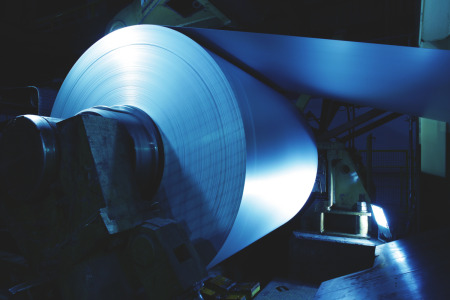
ResponsibleSteel is the first global certification initiative for sustainability in the steel industry. The Linz-based Steel Division is now one of the first steel companies worldwide to have been officially certified as a sustainable production site by the non-profit organization.
Certification required the entire location to be subjected to detailed examination by the independent global assurance provider LRQA. The precondition for certification was to fulfill 200 criteria which included the responsible procurement of raw materials, reducing carbon emissions, and the management of labor and human rights. The decision was made by an independent committee.
-
voestalpine.jpg)
At both the European and national level, the current climate debate primarily revolves around political targets for reducing CO2 emissions. In addition to the question of how steel will be produced in the long run, there also needs to be a focus on the contribution that steel already makes to sustainability. According to a study by the German Steel Federation (Wirtschaftsvereinigung Stahl) and the Boston Consulting Group on behalf of the EU28, high-tech steel used in lightweight automotive construction, more efficient electric motors and power plant turbines, or in generating renewable energies such as wind power, saves six times as much energy—and thus CO2—than is used in its production. That makes steel an essential element in a “sustainable” world.
Steel is able to demonstrate its strengths in e-mobility especially, because here every kilogram counts, not just in determining battery reach, but also stability and hence safety. This requires the use of ultra-light and high-strength steels, particularly for body parts. However, components such as battery housings which are specific to electric vehicles are also highly safety relevant. Consequently, suppliers in the steel industry are required to meet extremely stringent specifications, particularly in terms of crash behavior.
-
Sustainability indices function as a reference for investors who wish to entrust their money to socially and ecologically responsible companies. Only companies judged to be leaders in their industries according to long-term economic, ecological, and social criteria are included in these stock exchange listings.
voestalpine has been part of the FTSE4Good Index family since 2020, a well-respected sustainability index on the international stock markets. Each year, around 7,200 securities are evaluated according to strict ESG (environmental, social, and governance) criteria, with the criteria themselves defined and regularly updated by an independent committee of NGOs, consultants, public bodies, academics, corporate representatives, and the investment community.
In 2022 the voestalpine Group became the first and only European steel company to be listed on the renowned Dow Jones Sustainability Index Europe (DJSI Europe). The DJSI Europe is part of the globally recognized Dow Jones family of sustainability indices. It includes the top 20% of the 600 largest European companies in the S&P Global Broad Market IndexSM, who are leaders in the sustainability sector.